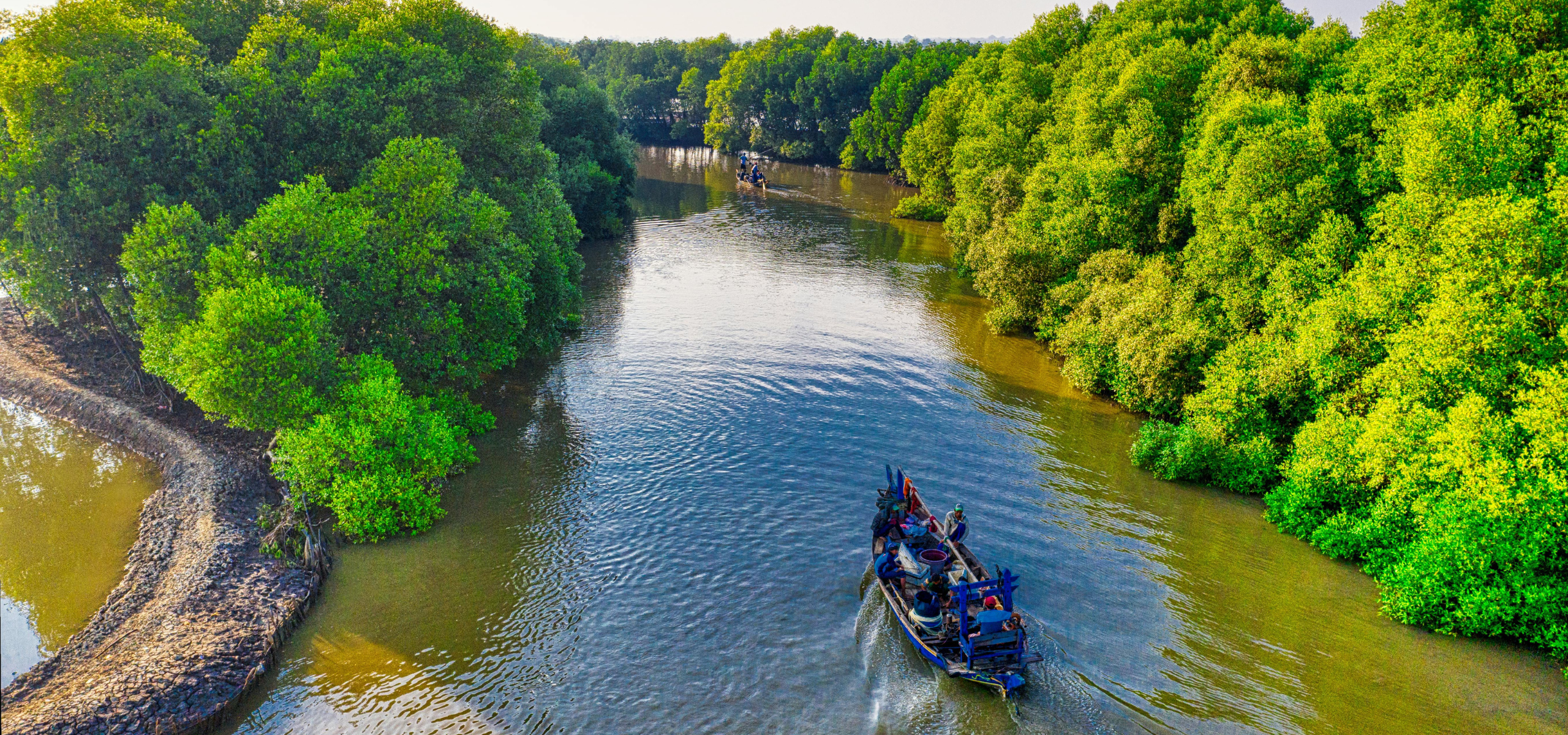
- Ecology
The role and limits of Ecosystem Services
Anna Paturau & Boris F. Mayer
- June 27, 2025
Two weeks ago, leaders, scientists, and civil society met at the World Summit on the Ocean with a shared call to expand marine protection, curb pollution, regulate the high seas, and unlock financing for vulnerable coastal nations. Beneath the pledges and data-driven targets, a deeper question surfaced: How do we truly value the living systems that allow life to persist?
Over the past twenty years, the concept of ecosystem services has moved from academic circles into mainstream policy and planning. It frames ecosystems as providers of benefits: food, clean water, air purification, flood protection, climate regulation, and even spiritual identity. This reframing has illuminated the hidden infrastructure of economies and societies, highlighting the interdependence of humans and nature.
But with rising prominence comes deeper questions: If our focus is only on what we can quantify, what gets left behind? If we see ecosystems simply as “service providers,” do we risk reducing living, relational systems to instruments of utility?
This article explores the role ecosystem services can play in informing decisions in Mauritius, probing both their power and their limits. As Blue Boa advocates for systems thinking and place-based strategy, our aim is to use this framework with care, clarity, and context—in pursuit of truly resilient outcomes.
Understanding Ecosystem Services
The term ecosystem services emerged in the 1970s from ecological research that sought to describe the tangible and intangible ways in which ecosystems support human life. It became mainstream following the Millennium Ecosystem Assessment (2005).
At its core, the concept reframes ecosystems as life-support systems—active, dynamic providers of essential goods and services. These are grouped into four broad categories:
- Provisioning: tangible resources—food, timber, freshwater, medicinal plants.
- Regulating: processes that stabilize systems—climate regulation, flood control, water purification, disease regulation.
- Cultural: non-material benefits—recreation, spiritual enrichment, identity, place-making.
- Supporting: foundational functions—nutrient cycling, soil formation, photosynthesis.
The ecosystem services framework has done more than just bring attention to nature’s benefits, it has helped bridge disciplines. Economists, planners, scientists, and policy-makers now share a language to talk about natural capital and ecological interdependence. It encourages decision-makers to see forests, wetlands, oceans, and urban green spaces not as vacant land or raw material, but as critical infrastructure for health, resilience, and prosperity.
Limits and risks: from insight to instrumentalism
Though illuminating, the ecosystem services lens comes with serious reservations:
• Anthropocentric bias
Framing ecosystems purely in terms of utility reinforces the notion that nature exists for us. This risks dismissing or undervaluing cultural, spiritual, and intrinsic values, especially those held by Indigenous or local communities.
• Measurement challenges
Many services, like carbon storage or cultural heritage, have no market price. Their valuation often depends on willingness-to-pay surveys, which may reflect social bias or ignore marginalized voices.
“Valuation is neither necessary nor sufficient for conservation. We conserve much that we do not value and do not conserve much that we value.”
— Geoffrey Heal
• Ecological simplification
Restoration projects focused solely on optimizing services can backfire. For example, mangrove planting aimed at carbon capture has, in some cases, disrupted sediment systems, reduced shorebird habitats, and displaced native species. These outcomes reflect a deeper issue: when ecosystems are framed only in terms of what they provide to humans, their complex, context-dependent functions can be oversimplified into static models, leading to well-meaning interventions that ignore ecological dynamics and produce unintended harm. (1)
This underscores how simplified service framings can undermine ecological complexity.
• The case for Ecosystem Functions
An increasing amount of studies argue for shifting from Ecosystems Services to Ecosystem Functions (EF). Ecosystems Function encompasses ecological processes regardless of their value to humans, highlighting intrinsic worth, interdependence, and system autonomy. Ecosystem function focuses on restoration and supports diversity, resilience, and redundancy, rather than narrow service optimization.
This does not render ES irrelevant but calls for their careful, context-sensitive application within a wider ecological and ethical framework.
What this means for Mauritius
A systems perspective on ecosystem services offers more than a new way to value nature, it provides a critical lens for rethinking Mauritius’s development trajectory. As the island faces interconnected pressures: climate instability, biodiversity loss, land-use conflicts, and socio-economic vulnerability, it becomes increasingly urgent to understand how the health of natural systems underpins national resilience, especially for the most exposed communities.
Ecosystem service assessments can help reveal these often-invisible dependencies, surfacing both opportunities and trade-offs. But for such insights to drive meaningful change, they must be matched by ethical, place-based, and forward-looking frameworks.
To illustrate how ecosystem services shape both environmental integrity and human well-being, we turn to two examples from the Mauritian context: watersheds and freshwater systems, and coastal ecosystems. Each highlights the complex ways in which natural infrastructure underpins biodiversity, economic activity, food security, and social resilience.
1. WATERSHEDS AND FRESHWATER SYSTEMS
Mauritius’s upland forests, wetlands, and soils play a crucial role in regulating the island’s hydrology. These ecosystems help control water flow, reduce erosion, filter pollutants, and recharge aquifers. When functioning well, they stabilize agriculture, prevent flood damage, and support reliable water supply.
Yet these services are rarely priced into infrastructure decisions. Integrating ecosystem knowledge into land-use planning could help reduce future costs, prevent conflict over water access, and increase the resilience of food systems, especially in the face of shifting rainfall patterns and rising drought risk.
2. COASTAL ECOSYSTEMS
Mangroves, coral reefs, and seagrasses form a second layer of protection and productivity around the island. Their benefits are widely recognized: buffering coastlines, providing nursery habitats, sequestering carbon, and sustaining tourism.
But these services go far beyond ecological function, they are deeply lived. A 2023 study by the Charles Telfair Institute (2) highlights how, in several coastal villages, mangroves are central to identity and survival. They provide food, livelihoods, and a sense of place. For households with limited income options, these ecosystems are not supplementary—they are essential.
The study also found that the more a household depends on these ecosystems, the more vulnerable it becomes when those ecosystems are degraded. In other words, ecological fragility becomes a social risk. Protecting mangroves is thus not just an environmental priority, it is a matter of human security.
Mauritius is not only facing an ecological challenge; it stands at a developmental crossroads. The way we value, govern, and restore ecosystems today will define whether our future pathways reinforce short-term productivity or build long-term resilience.
Ecosystem services can help clarify what is at stake. But they must be used not just to measure, but to guide decisions that account for ecological complexity, respond to social realities, and prioritize regeneration as a foundation for long-term resilience and well-being.
From metrics to meaning: Designing with living systems in mind
Ecosystem services have helped translate ecology into the language of decision-making. But as environmental and economic pressures mount, we need more than tools that measure impact, we need frameworks that reshape intention.
The central question is no longer just: How do ecosystems serve us?
A deeper and more regenerative inquiry is: How can our systems of production, governance, and investment begin to serve ecosystems?
For leaders, planners, and businesses, this requires a fundamental shift:
From viewing ecosystems as suppliers of value, to recognizing them as co-architects of resilience.
To move from insight to application, four pragmatic principles emerge:
Plan with ecological intelligence
Embed ecological understanding into every stage of strategy and design, not as a constraint, but as a source of innovation. This means working with natural rhythms, thresholds, and feedback loops rather than imposing artificial growth curves.
Support system functions, not just service flows
Value what keeps ecosystems alive, not just what they deliver. Resilience depends on complexity, diversity, and interdependence; qualities that don’t always appear on balance sheets but shape long-term stability.
Make space for reciprocity
We cannot possibly know, or measure all the benefits healthy ecosystems provide. Many of their functions are hidden, indirect, or only understood in hindsight. Designing with reciprocity means restoring and maintaining ecosystems not only for what they yield, but because they are life-supporting systems in their own right. It calls for integrating restorative actions into core business practices and policies. Reciprocity acknowledges that healthy ecosystems underpin all human wellbeing and that investing in their recovery is both a responsibility and a strategic opportunity.
Center place in decision-making
Every ecosystem is unique. Use local knowledge, cultural insights, and site-specific data to shape interventions that are context-responsive, equitable, and effective.
In a time of overlapping crises (ecological, climatic, and social) restoring the conditions for life must become a shared strategic priority. The ecosystem services framework is a critical step toward this, but the goal is not simply to measure more. It is to participate differently, with humility, imagination, and a long-term perspective.
(1) Ferraro, K. M., Ferraro, A. L., Lundgren, E., & Sommer, N. R. (2025). The use and abuse of ecosystem service concepts and terms. Biological Conservation 308, 111218.
(2) Merven, R., Appadoo, C., Florens, F.B.V., & Iranah, P. (2023). Mangroves are essential for coastal livelihoods and local resilience – insights from Mauritius. Charles Telfair Centre. April 18, 2023. Retrieved from: https://charlestelfaircentre.com/mangroves-mauritius/
Join our newsletter
Subscribe to our newsletter to follow how we are striving to make a positive impact


